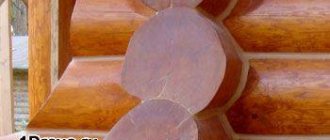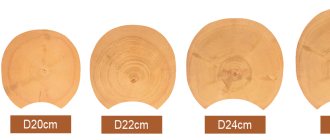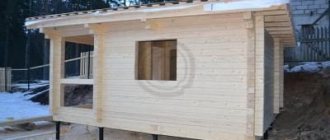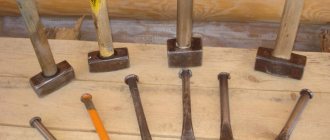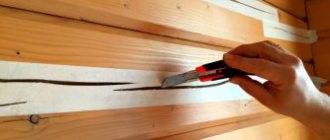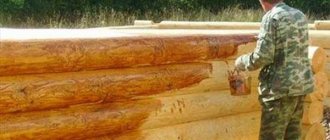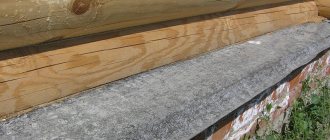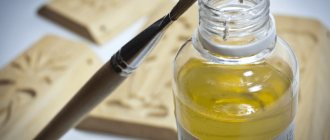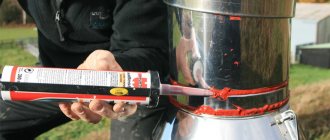Construction of log houses is not an easy task and it must be carried out in compliance with all technologies. Then the finished wooden structure will not only be attractive in appearance, but also warm, comfortable and durable. One of the important stages of such construction is non-contact abrasive jet grinding of the log house, which is carried out using a sandblasting machine and fine-grained abrasive. The sand mixture is fed to the surface under high pressure and produces deep but accurate processing of the wood without causing even the slightest damage.
Why is grinding of a log house needed?
Thanks to correctly performed grinding of the log house, the old darkened layer is removed.
This improves not only the appearance of the house, but also allows you to restore the natural properties of wood and improve its quality. During the grinding of the log house, the following are also eliminated:
- mechanical damage to the log,
- exposed resin,
- resin pockets,
- remnants of bark,
- mold,
- not deep blue.
To properly carry out sanding at home, you need to have small, but extremely important knowledge and understand the differences between sanding methods, since today they can be divided into three main methods.
Why is grinding needed?
Many people are concerned with the question: why polish a log house? There are many knots, irregularities and other defects on the surface of the logs that spoil the appearance of the structure and can be removed by sanding. Not only houses made of debarked logs and unplaned timber need sanding, but also houses made of any other lumber, regardless of its quality.
This operation is especially important for solid and profile timber with natural moisture. A house made of professional timber, left for a long time without chemical impregnation, becomes covered with an unsightly blue coating, which is removed by sanding. However, a house made of imitation timber will not look perfect without sanding.
On the surface of even lumber processed during the production process there are roughnesses, uneven color, cracks and chips, which cannot be removed without sanding. The sanded surface is an excellent basis for subsequent painting work. Painting a log frame without sanding can cause a short service life of the coating.
Sanding a wooden house allows you to solve many problems at once:
- level the surface of logs or beams, make it perfectly smooth;
- discover all the beauty of the natural texture of wood, which, under the influence of sanding, becomes more saturated and bright;
- remove fibers, roughness, knots and other minor defects;
- remove visible blue stains, get rid of fungus and mold if they have already settled in the wood, and also prevent their formation;
- ensure better penetration of protective antiseptics and primers into the structure of the material;
- prepare the surface for painting and varnishing;
- renew the surface of the old log house.
Many people doubt whether it is necessary to sand a rounded log before painting, or whether paint can be applied to wood without prior preparation. Experts believe that sanding is necessary before painting any lumber. It is necessary to ensure good adhesion of the paint and varnish material to the surface. The paint will lie unevenly on an unsanded surface, and all the unevenness of the wood will appear on the front layer.
Sanding the frame with nylon brushes.
When sanding a house using nylon brushes, all visible defects are also removed from the frame, but labor costs increase, as more complex defects, such as: resin pockets, shallow blue discoloration, mechanical damage, resin; You will have to first remove it using sanding discs, and then do the finishing sanding with nylon brushes. And the procedure itself for sanding a log house with nylon brushes takes a little longer than with sanding discs. But there is one big difference worth noting! After nylon brushes, the wood grain appears more clearly on the log house.
Before we start finishing the log house with nylon brushes , we treat it with a flap disk, removing all mechanical damage to the logs, as well as natural defects, namely: resin pockets, hardened resin, etc.
After this, various types of nylon brushes from the German company “Osborn” are used. If the log is difficult to machine, then first we use a nylon brush with P46 grit. After hard-to-cut logs have been rough-sanded, we proceed to finishing using P80 or P120 grit brushes.
Features of wooden coatings, purpose of sanding and necessary tools
Any type of wood is to one degree or another susceptible to environmental influences. Rotting, insects, drying out and warping are just some of the potential problems inherent in wood. In the natural environment, such impacts may be almost unnoticeable, but in the conditions of your own home it is simply impossible not to notice them. During the preparation process, the wood undergoes initial sanding, trimming and antifungal treatment. However, over time, any timber gradually dries out, releasing remaining moisture into the environment. As a result, the top layer of material loses its appearance and becomes defenseless for parasites or mold fungi.
You can solve this problem and restore the lost shine to wooden walls by sanding. The point of this procedure is to remove several of the upper balls of the material and reveal the structure of the wood. It is these layers that are most susceptible to changes, and their removal makes it possible to completely restore the appearance of the wood.
Sanding the walls of a wooden house should not be carried out immediately after completion of its installation. The finished building must remain stable for at least 5-6 months, during which the material will completely dry and take its final shape. Sanding immediately after installing the logs will not solve the problem, since the wood still needs some time to dry. Maintaining the required period allows you to obtain the most colorful and high-quality surface. To secure the texture, a variety of paints and varnishes are used to preserve the necessary shades and make the design more expressive.
Sanding wooden walls with your own hands is not difficult. However, the process itself is quite labor-intensive and painstaking, since each centimeter of surface has to be processed 2-3 times.
The following materials will help to carry out a complete sanding of a log house:
- sander;
- sandpaper (fractions 40 and 100);
- chisel;
- hammer;
- personal protective equipment.
The main tool for the job is a sander. It can be professional or made on the basis of an angle grinder; in any case, processing will not be difficult. The main condition for working with such a device is the presence of a construction vacuum cleaner, which will absorb all the dust generated during the processing process. It is also not recommended to start work without protective equipment such as gloves, goggles and a respirator.
Sanding a log frame with sanding discs
When using sanding with sanding discs, a significant layer of wood is removed from the frame, which in turn leads to an even color of the material and removes 99% of all visible defects. But, on the other hand, after sanding small irregularities will appear on the log house, and the wood grain will be less pronounced.
When sanding a log house with sanding discs, the same principle is used as when sanding a house with nylon brushes. If the log is difficult to machine, we take a disc with a larger P60 grain, and after that we proceed to final grinding of the log house with discs with a P80 or P120 grain.
Where to order the service?
A service such as sandblasting of a log frame has appeared on the market recently, but is already in great demand in the private housing construction sector. A specialized company provides this type of service and is ready to perform high-quality grinding, polishing of walls, as well as coating the log surface with reliable protective compounds.
All work is carried out by the company's specialists using modern tools and professional equipment. You can find out how much abrasive jet grinding of a log house in Moscow costs on the website in the “Price” section or from a specialist by contacting him by phone listed in the “Contacts” section. The final cost of the work, which usually includes consumables, preparation and dismantling of scaffolding, garbage removal, etc., is determined by the master during a personal inspection of the object.
Sandblasting a log frame.
During the processing of a log house using the abrasive-jet method using sandblasting, deep processing of the wood occurs, which leads to brushing of the surface, that is, to a more obvious manifestation of the pattern. Using this method, it is possible to perform a deeper brushing of the log house, as a result the surface will become more corrugated, with a clearly defined wood pattern.
Sandblasting a log house requires the use of special equipment: a sandblasting machine, a compressor and special consumables consisting of a certain type of sand. The processing of the log house is carried out using a non-contact method, the mixture is supplied under high pressure to the surface being treated. Thanks to contactless processing, there are no traces left on the log house, such as unevenness, scorching, etc.
Sanding a house using the abrasive jet method is non-contact. Using a sandblasting machine and a powerful compressor, a special sand mixture is supplied to the log house under high pressure, which avoids any mechanical damage to the log house and significantly increases the speed and quality of work.
Advantages of using the method
Sandblasting of a log frame is an innovative wood processing technology. Unlike traditional grinding methods using grinders, grinders and attachment wheels, it is performed much more efficiently and quickly.
Sandblasting is used not only for log buildings, but also for buildings made of timber and lining. Non-contact sandblasting makes it possible to quickly clean the log/timber surface from various types of contaminants, old paint, mold and discoloration. In addition, sandblasting of a log building:
- provides high quality grinding;
- evenly removes the top layer of wood;
- has a delicate effect and does not damage the wood;
- gives the wood texture a more refined and beautiful look;
- makes the surface of the log more dense and therefore durable;
- significantly increases the absorption of painting and protective materials;
- allows you to process hard-to-reach places - corners, joints, ends, etc.
Technologically competent sandblasting of a log house and its painting make it possible to obtain luxury-class walls and other architectural elements, as well as significantly improve their performance.
Grinding the ends of the log house
At the first stage, we process the ends of the frame with special steel discs of the “Alfadisk Strong No. 2 Extra (3mm)” series. Discs with a grain size of 3 mm allow you to quickly and smoothly remove the most problematic areas on the ends of logs: protrusions, irregularities, curvatures; and give them an even plane without various defects and differences.
Thanks to the larger grain size, the disc penetrates deeply into the ends of the log, which avoids the use of additional tools to give the ends of the logs an even plane along the entire cutting height.
We use “Alfadisc No. 5 Light (0.5 mm)” discs with a grain size of 0.5 mm for chamfering the ends of logs to give the log a more neat and finished look.
After the rough processing of the ends of the frame has been completed, we begin finishing processing. For finishing the ends we use a P80 grit flap disc.
When to Sand
The first work that is performed at the construction stage or immediately after the construction of a log or timber house is the initial caulking of the roof joints. Sanding can begin only after the wooden house has undergone shrinkage and the wood has completely dried. This condition is especially important to comply with if a house or bathhouse is built from logs of natural moisture.
Undried wood does not allow for high-quality sanding; it must be allowed to settle and dry. This can take from six months to two years, depending on the time of installation and the moisture content of the wood. During drying, fibers rise in the wood and all its defects appear, which are easily removed during the sanding process.
Profiled timber can be sanded no earlier than 10-12 months after construction. If the house is made of glued or dried rounded timber, you can start sanding immediately after it is placed under the roof and caulked. A house made of laminated veneer lumber exhibits slight shrinkage, which cannot lead to significant deformation of the walls.
A polished surface cannot remain untreated for a long time. Within a week after sanding, the logs of the log house must be treated with an antiseptic composition. If you miss time, the wood will begin to darken and acquire a blue tint.
Sanding of logs must be carried out not only after the construction of a new house, but also after 5-7 years of operation of the building, when the time comes to change the old wall covering. Sanding removes old paintwork, lightens the color of the wood, and prepares it for painting.
What tool are we using?
We do not use classic grinders, as they have a very large number of revolutions. When using nylon brushes, and even sanding pads, this factor can cause burning of the wood during work, which will leave very unsightly marks on the surface of the material being processed.
In our work, we use polishing machines and work at medium speeds, approximately 1900 rpm. This increases the time for surface treatment, but significantly improves the quality of the final result.
When sanding with nylon brushes, we use only proven German brushes from Osborn.
To significantly gain time when treating the house using the abrasive blasting method, we purchased a large-volume sandblasting machine - 75 liters, which allows us to process up to 27 m²/hour.
Self-grinding mistakes
The technology of grinding a log frame at first glance seems quite simple, and many mistakenly believe that this work does not require special skills and experience. Actually this is not true. To achieve the desired effect by sanding, skill and precision are required. A person who does not have special qualifications and experience, including the skills to use a grinding tool, can only cause harm with his unprofessionalism.
If sanded incorrectly, unwanted chips, depressions and grooves may appear on the surface, which will affect the appearance. If the surface is not smooth enough, the absorption of antiseptics will deteriorate and paint consumption will increase. Sanding hard-to-reach places is especially difficult; it is not so easy to sand a house in the corners and ends.
During grinding, no matter how carefully the surface is sanded, dust will inevitably appear, so it is necessary to use respiratory protective equipment when working. In addition, you will have to stock up on a large number of attachments of different sizes, since they have to be changed very often. The grain quickly wears out and becomes clogged with flying dust and resin. This results in high costs, since replacement wheels are not cheap.

